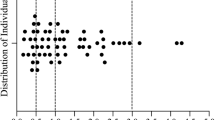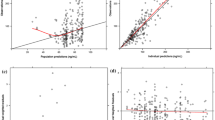Abstract
Purpose
Enteric-coated mycophenolate sodium (EC-MPS) is effective and safe in preventing rejection after transplantation and is mainly transported by ABCs and OATPs and metabolized by UGTs. The genetic polymorphisms affect the inter-individual variation in drug disposition and elimination. The aims of this study were to develop a population pharmacokinetic (PK) model and to evaluate the influence of genetic and clinical factors on the PK of mycophenolic acid (MPA) in Korean renal transplant recipients.
Methods
Population analysis of EC-MPS was performed using non-linear mixed effects modeling (NONMEM). After clinical and genetic factors were evaluated using a stepwise covariate method, we selected clinically relevant covariates considering covariate effects. The final model was validated by bootstrap and visual predictive check. At last, we performed the model-based simulations in order to explore an optimal dose to achieve target area under the curve (AUC) in hypothetical scenarios.
Results
From 166 plasma concentrations (n=34), a time-lagged two-compartment with a flip-flop model best describes the PK of MPA. The covariate analysis identified lower creatinine clearance (CLcr) and SLCO1B1 variant genotype were correlated with lower MPA clearance, on the contrary, UGT1A9 variant had decreased distribution of MPA, contributing to lower absorption. When considering to UGT1A9, SLCO1B1 genotypes, and renal function, the new recommended dose of 540 mg twice daily resulted in a higher success of achieving the target AUC0-12h in the 30-60 mg.h/L.
Conclusions
CLcr, UGT1A9 and SLCO1B1 genotypes seem to be promising parameters to predict the pharmacokinetics with flip-flop phenomenon of EC-MPS in transplant recipient having stable renal function. This model on clinical practice may help prevent overexposure and achieve a proper AUC in the Korean population.



Similar content being viewed by others
References
Salvadori M, Holzer H, de Mattos A, Sollinger H, Arns W, Oppenheimer F, Maca J, Hall M, Grp EBS (2004) Enteric-coated mycophenolate sodium is therapeutically equivalent to mycophenolate mofetil in de novo renal transplant patients. Am J Transplant 4(2):231–236. doi:10.1046/j.1600-6143.2003.00337.x
Budde K, Curtis J, Knoll G, Chan L, Neumayer HH, Seifu Y, Hall M, Grp EBS (2004) Enteric-coated mycophenolate sodium can be safely administered in maintenance renal transplant patients: results of a 1-year study. Am J Transplant 4(2):237–243. doi:10.1046/j.1600-6143.2003.00321.x
Staatz CE, Tett SE (2007) Clinical pharmacokinetics and pharmacodynamics of mycophenolate in solid organ transplant recipients. Clin Pharmacokinet 46(1):13–58
Bernard O, Tojcic J, Journault K, Perusse L, Guillemette C (2006) Influence of nonsynonymous polymorphisms of UGT1A8 and UGT2B7 metabolizing enzymes on the formation of phenolic and acyl glucuronides of mycophenolic acid. Drug Metab Dispos 34(9):1539–1545. doi:10.1124/dmd.106.010553
Picard N, Ratanasavanh D, Premaud A, Le Meur Y, Marquet P (2005) Identification of the UDP-glucuronosyltransferase isoforms involved in mycophenolic acid phase II metabolism. Drug Metab Dispos 33(1):139–146. doi:10.1124/dmd.104.001651
Levesque E, Delage R, Benoit-Biancamano MO, Caron P, Bernard O, Couture F, Guillemette C (2007) The impact of UGT1A8, UGT1A9, and UGT2B7 genetic polymorphisms on the pharmacokinetic profile of mycophenolic acid after a single oral dose in healthy volunteers. Clin Pharmacol Ther 81(3):392–400. doi:10.1038/sj.clpt.6100073
Satoh S, Tada H, Murakami M, Tsuchiya N, Li Z, Numakura K, Saito M, Inoue T, Miura M, Hayase Y, Suzuki T, Habuchi T (2006) Circadian pharmacokinetics of mycophenolic acid and implication of genetic polymorphisms for early clinical events in renal transplant recipients. Transplantation 82(4):486–493. doi:10.1097/01.tp.0000231874.53240.ba
Suzuki H, Sugiyama Y (2002) Single nucleotide polymorphisms in multidrug resistance associated protein 2 (MRP2/ABCC2): its impact on drug disposition. Adv Drug Deliv Rev 54(10):1311–1331
Baldelli S, Merlini S, Perico N, Nicastri A, Cortinovis M, Gotti E, Remuzzi G, Cattaneo D (2007) C-440 T/T-331C polymorphisms in the UGT1A9 gene affect the pharmacokinetics of mycophenolic acid in kidney transplantation. Pharmacogenomics 8(9):1127–1141. doi:10.2217/14622416.8.9.1127
van Schaik RH, van Agteren M, de Fijter JW, Hartmann A, Schmidt J, Budde K, Kuypers D, Le Meur Y, van der Werf M, Mamelok R, van Gelder T (2009) UGT1A9–275T > A/-2152C > T polymorphisms correlate with low MPA exposure and acute rejection in MMF/tacrolimus-treated kidney transplant patients. Clin Pharmacol Ther 86(3):319–327. doi:10.1038/clpt.2009.83
Kuypers DR, Naesens M, Vermeire S, Vanrenterghem Y (2005) The impact of uridine diphosphate-glucuronosyltransferase 1A9 (UGT1A9) gene promoter region single-nucleotide polymorphisms T-275A and C-2152 T on early mycophenolic acid dose-interval exposure in de novo renal allograft recipients. Clin Pharmacol Ther 78(4):351–361. doi:10.1016/j.clpt.2005.06.007
Girard H, Court MH, Bernard O, Fortier LC, Villeneuve L, Hao Q, Greenblatt DJ, von Moltke LL, Perussed L, Guillemette C (2004) Identification of common polymorphisms in the promoter of the UGT1A9 gene: evidence that UGT1A9 protein and activity levels are strongly genetically controlled in the liver. Pharmacogenetics 14(8):501–515
Yamanaka H, Nakajima M, Katoh M, Hara Y, Tachibana O, Yamashita J, McLeod HL, Yokoi T (2004) A novel polymorphism in the promoter region of human UGT1A9 gene (UGT1A9*22) and its effects on the transcriptional activity. Pharmacogenetics 14(5):329–332
Zhang WX, Chen B, Jin Z, Yu Z, Wang X, Chen H, Mao A, Cai W (2008) Influence of uridine diphosphate (UDP)-glucuronosyltransferases and ABCC2 genetic polymorphisms on the pharmacokinetics of mycophenolic acid and its metabolites in Chinese renal transplant recipients. Xenobiotica Fate Foreign Compd Biol Syst 38(11):1422–1436. doi:10.1080/00498250802488585
Guo D, Pang LF, Han Y, Yang H, Wang G, Tan ZR, Zhang W, Zhou HH (2013) Polymorphisms of UGT1A9 and UGT2B7 influence the pharmacokinetics of mycophenolic acid after a single oral dose in healthy Chinese volunteers. Eur J Clin Pharmacol 69(4):843–849. doi:10.1007/s00228-012-1409-0
Miura M, Satoh S, Inoue K, Kagaya H, Saito M, Inoue T, Suzuki T, Habuchi T (2007) Influence of SLCO1B1, 1B3, 2B1 and ABCC2 genetic polymorphisms on mycophenolic acid pharmacokinetics in Japanese renal transplant recipients. Eur J Clin Pharmacol 63(12):1161–1169. doi:10.1007/s00228-007-0380-7
Michelon H, Konig J, Durrbach A, Quteineh L, Verstuyft C, Furlan V, Ferlicot S, Letierce A, Charpentier B, Fromm MF, Becquemont L (2010) SLCO1B1 genetic polymorphism influences mycophenolic acid tolerance in renal transplant recipients. Pharmacogenomics 11(12):1703–1713. doi:10.2217/pgs.10.132
Picard N, Yee SW, Woillard JB, Lebranchu Y, Le Meur Y, Giacomini KM, Marquet P (2010) The role of organic anion-transporting polypeptides and their common genetic variants in mycophenolic acid pharmacokinetics. Clin Pharmacol Ther 87(1):100–108. doi:10.1038/clpt.2009.205
Cox VC, Ensom MH (2003) Mycophenolate mofetil for solid organ transplantation: does the evidence support the need for clinical pharmacokinetic monitoring? Ther Drug Monit 25(2):137–157
Knight SR, Morris PJ (2008) Does the evidence support the use of mycophenolate mofetil therapeutic drug monitoring in clinical practice? A systematic review. Transplantation 85(12):1675–1685. doi:10.1097/Tp.0b013e3181744199
Arns W, Cibrik DM, Walker RG, Mourad G, Budde K, Mueller EA, Vincenti F (2006) Therapeutic drug monitoring of mycophenolic acid in solid organ transplant patients treated with mycophenolate mofetil: review of the literature. Transplantation 82(8):1004–1012. doi:10.1097/01.tp.0000232697.38021.9a
van Hest RM, Mathot RA, Pescovitz MD, Gordon R, Mamelok RD, van Gelder T (2006) Explaining variability in mycophenolic acid exposure to optimize mycophenolate mofetil dosing: a population pharmacokinetic meta-analysis of mycophenolic acid in renal transplant recipients. J Am Soc Nephrol 17(3):871–880. doi:10.1681/ASN.2005101070
Hale MD, Nicholls AJ, Bullingham RE, Hene R, Hoitsma A, Squifflet JP, Weimar W, Vanrenterghem Y, Van de Woude FJ, Verpooten GA (1998) The pharmacokinetic-pharmacodynamic relationship for mycophenolate mofetil in renal transplantation. Clin Pharmacol Ther 64(6):672–683. doi:10.1016/S0009-9236(98)90058-3
Henin E, Bergstrand M, Standing JF, Karlsson MO (2012) A mechanism-based approach for absorption modeling: the gastro-intestinal transit time (GITT) model. AAPS J 14(2):155–163. doi:10.1208/s12248-012-9324-y
Yanez JA, Remsberg CM, Sayre CL, Forrest ML, Davies NM (2011) Flip-flop pharmacokinetics—delivering a reversal of disposition: challenges and opportunities during drug development. Ther Deliv 2(5):643–672. doi:10.4155/tde.11.19
(2012) Product Information: Myfortic(R) oral delayed release tablets, mycophenolic acid oral delayed release tablets. In: ed. Novartis (per FDA)
Borrows R, Chusney G, James A, Stichbury J, Van Tromp J, Cairns T, Griffith M, Hakim N, McLean A, Palmer A, Papalois V, Taube D (2005) Determinants of mycophenolic acid levels after renal transplantation. Ther Drug Monit 27(4):442–450
van Hest RM, van Gelder T, Vulto AG, Mathot RA (2005) Population pharmacokinetics of mycophenolic acid in renal transplant recipients. Clin Pharmacokinet 44(10):1083–1096. doi:10.2165/00003088-200544100-00006
Bernard O, Guillemette C (2004) The main role of UGT1A9 in the hepatic metabolism of mycophenolic acid and the effects of naturally occurring variants. Drug Metab Dispos 32(8):775–778
Ting LS, Benoit-Biancamano MO, Bernard O, Riggs KW, Guillemette C, Ensom MH (2010) Pharmacogenetic impact of UDP-glucuronosyltransferase metabolic pathway and multidrug resistance-associated protein 2 transport pathway on mycophenolic acid in thoracic transplant recipients: an exploratory study. Pharmacotherapy 30(11):1097–1108. doi:10.1592/phco.30.11.1097
Jada SR, Xiaochen S, Yan LY, Xiaoqiang X, Lal S, Zhou SF, Ooi LL, Chowbay B (2007) Pharmacogenetics of SLCO1B1: haplotypes, htSNPs and hepatic expression in three distinct Asian populations. Eur J Clin Pharmacol 63(6):555–563. doi:10.1007/s00228-007-0285-5
Jindal C, Kumar S, Choudhari G, Goel H, Mittal B (2009) Organic anion transporter protein (OATP1B1) encoded by SLCO1B1 gene polymorphism (388A > G) & susceptibility in gallstone disease. Indian J Med Res 129(2):170–175
Miura M, Kagaya H, Satoh S, Inoue K, Saito M, Habuchi T, Suzuki T (2008) Influence of drug transporters and UGT polymorphisms on pharmacokinetics of phenolic glucuronide metabolite of mycophenolic acid in Japanese renal transplant recipients. Ther Drug Monit 30(5):559–564. doi:10.1097/FTD.0b013e3181838063
Kornberg A, Kupper B, Hommann M, Scheele J (2005) Introduction of MMF in conjunction with stepwise reduction of calcineurin inhibitor in stable liver transplant patients with renal dysfunction. Int Immunopharmacol 5(1):141–146. doi:10.1016/j.intimp.2004.09.018
Sarangi SC, Reeta KH, Agarwal SK, Kaleekal T, Guleria S, Gupta YK (2012) A pilot study on area under curve of mycophenolic acid as a guide for its optimal use in renal transplant recipients. Indian J Med Res 135:84–91
Kuypers DR, de Jonge H, Naesens M, de Loor H, Halewijck E, Dekens M, Vanrenterghem Y (2008) Current target ranges of mycophenolic acid exposure and drug-related adverse events: a 5-year, open-label, prospective, clinical follow-up study in renal allograft recipients. Clin Ther 30(4):673–683
Bruchet NK, Ensom MH (2009) Limited sampling strategies for mycophenolic acid in solid organ transplantation: a systematic review. Expert Opin Drug Metab Toxicol 5(9):1079–1097. doi:10.1517/17425250903114182
Sanchez Fructuoso AI, Perez-Flores I, Calvo N, Valero R, Matilla E, Ortega D, Del Dedo MA, Fernandez-Perez C, Barrientos A (2012) Limited-sampling strategy for mycophenolic acid in renal transplant recipients reciving enteric-coated mycophenolate sodium and tacrolimus. Ther Drug Monit 34(3):298–305. doi:10.1097/FTD.0b013e318255cc15
Acknowledgments
This work was supported by a Grant (11182MFDS660) from the Ministry of Food and Drug Safety in 2012 and the National Research Foundation of Korea grant, funded by the Korean Government Ministry of Science, ICT and Future Planning (no. NRF-2009-00081414).
Authorship
N.H. participated in research design, performance of the research, data analysis, and writing of the paper; H.Y. participated in research design, data analysis, and writing of the paper; I.K. participated in research design, data analysis, and writing of the paper; Y.O. and Y.K. participated in performance of the research and data analysis; J.O. participated in research design and writing of the paper.
Grants
This work was supported by the grant (11182MFDS660) from the Ministry of Food and Drug Safety in 2012 and the National Research Foundation of Korea grant, funded by the Korean Government Ministry of Science, ICT and Future Planning (no. NRF-2009-00081414).
Conflict of interest
All authors declared no conflict of interest.
Author information
Authors and Affiliations
Corresponding author
Electronic supplementary material
Below is the link to the electronic supplementary material.
ESM 1
(DOCX 137 kb)
Rights and permissions
About this article
Cite this article
Han, N., Yun, Hy., Kim, IW. et al. Population pharmacogenetic pharmacokinetic modeling for flip-flop phenomenon of enteric-coated mycophenolate sodium in kidney transplant recipients. Eur J Clin Pharmacol 70, 1211–1219 (2014). https://doi.org/10.1007/s00228-014-1728-4
Received:
Accepted:
Published:
Issue Date:
DOI: https://doi.org/10.1007/s00228-014-1728-4




